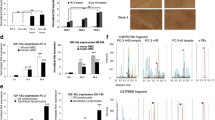Abstract
The expression of SERPINA1 gene in prostate (DU145, PC-3 and LNCaP) and liver (HepG2) tumor cell lines was studied. Alpha1-antitrypsin (AAT) level in the whole cell extracts, secretomes, subcellular fractions and SERPINA1 mRNA level in the corresponding cells were detected. Discordance between expression at these two levels in PC-3 and LNCaP lines was revealed. A new 37 kDa AAT N-terminus truncated isoform was detected in the nuclear extracts of some prostate tumor cell lines. The mechanism of 37 kDa AAT isoform intracellular retention was proposed. Two polyadenylation sites in the 3'-untranslated region of SERPINA1 transcripts were identified. A SERPINA1 gene 3'-untranslated region influence on AAT translation has been discussed.
Similar content being viewed by others
References
Rowe, R.G. and Weiss, S.J., Navigating ECM barriers at the invasive front: the cancer cell–stroma interface, Annu. Rev. Cell Dev. Biol., 2009, vol. 25, pp. 2009–25.
Friedl, P. and Wolf, K., Tube travel: the role of proteases in individual and collective a cancer cell invasion, Cancer Res., 2008, vol. 68, no. 18, pp. 7247–7249.
Wolf, K., Wu, Y.I., Liu, Y., Geiger, J., Tam, E., Overall, C., Stack, M.S., and Friedl, P., Multi-step pericellular proteolysis controls the transition from individual to collective cancer cell invasion, Nat. Cell Biol., 2007, vol. 9, no. 8, pp. 893–904.
Perlmutter, D.H., Cole, F.S., Kilbridge, P., Rossing, Th., and Colten, H.R., Expression of the alpha 1-proteinase inhibitor gene in human monocytes and macrophages, Proc. Natl. Acad. Sci. USA, 1985, vol. 82, no. 3, pp. 795–799.
Wozniak, A., Mila-Kierzenkowska, C., Schachtschabel, D.O., Wozniak, B., Rozwodowska, M., Drewa, T., Drewa, S., Sir, J., Sir, I., Maciak, R., and KrzyzynskaMalinowska, E., Activity of cathepsin D and alpha(1)antitrypsin in the blood serum of patients with mammary carcinoma, Exp. Oncol., 2005, vol. 27, no. 3, pp. 233–237.
Dokrunova, A.A., Ulasova, N.Yu., Kramina, T.E., Al’bitskii, I.A., Khasigov, P.Z., and Sokolova, O.S., Polymorphism of alpha-1 antitrypsin in cancer and benign prostatic hyperplasia, Mol. Med., 2010, no. 6, pp. 43–49.
Kataoka, H., Seguchi, K., Inoue, T., and Koono, M., Properties of alpha 1-antitrypsin secreted by human adenocarcinoma cell lines, FEBS Lett., 1993, vol. 328, no. 3, pp. 291–295.
Lejeune, P.J., Mallet, B., Farnarier, C., and Kaplanski, S., Changes in serum level and affinity for concanavalin a of human alpha 1-proteinase inhibitor in severe burn patients: relationship to natural killer cell activity, Biochim. Biophys. Acta, 1989, vol. 990, no. 2, pp. 122–127.
Fukushima, M., Fukuda, Y., Kawamoto, M., and Yamanaka, N., Elastosis in lung carcinoma: immunohistochemical, ultrastructural and clinical studies, Pathol. Int., 2000, vol. 50, no. 8, pp. 626–635.
Dokrunova, A.A. and Sokolova, O.S., Content of a1antitrypsin in serum in prostate diseases, Urologiya, 2012, no. 5, pp. 77–80.
Kent, W.J., Sugnet, C.W., Furey, T.S., Roskin, K.M., Pringle, Th., Zahler, A.M., and Haussler, D., The human genome browser at UCSC, Genome Res., 2002, vol. 12, no. 6, pp. 996–1006.
Pfaffle, M.W., A new mathematical model for relative quantification in real-time RT-PCR, Nucleic Acids Res., 2001, vol. 29, no. 9, p. e45.
Rosner, M., Schipany, K., and Hengstschlager, M., Merging high-quality biochemical fractionation with a refined flow cytometry approach to monitor nucleocytoplasmic protein expression throughout the unperturbed mammalian cell cycle, Nat. Protoc., 2013, vol. 8, no. 3, pp. 602–626.
Feng, L. and Arvan, P., The trafficking of alpha 1-antitrypsin, a post-golgi secretory pathway marker, in INS-1 pancreatic beta cells, J. Biol. Chem., 2003, vol. 278, no. 34, pp. 31486–31494.
Owen, M.C., Brennan, S.O., Lewis, J.H., and Carrell, R.W., Mutation of antitrypsin to antithrombin. alpha 1antitrypsin Pittsburgh (358 Met leads to Arg), a fatal bleeding disorder, N. Engl. J. Med., 1983, vol. 309, no. 12, pp. 694–698.
Samandari, T. and Brown, J.L., A study of the effects of altering the sites for N-glycosylation in alpha-1-proteinase inhibitor variants M and S, Protein Sci., 1993, vol. 2, no. 9, pp. 1400–1410.
Mayr, C. and Bartel, D.P., Widespread shortening of 3' UTRs by alternative cleavage and polyadenylation activates oncogenes in cancer cells, Cell, 2009, vol. 138, no. 4, pp. 673–684.
Saito, S., Hosoda, N., and Hoshino, S., The Hbs1Dom34 protein complex functions in non-stop mRNA decay in mammalian cells, J. Biol. Chem., 2013, vol. 288, no. 24, pp. 17832–17843.
Hassan, T., Smith, S.G., Gaughan, K., and Oglesby, I.K., O’Neill, A., McElvaney, N.G., and Greene, C.M., Isolation and identification of cell-specific micrornas targeting a messenger RNA using a biotinylated anti-sense oligonucleotide capture affinity technique, Nucleic Acids Res., 2013, vol. 41, no. 6, p. e71.
Sandberg, R., Neilson, J.R., Sarma, A., Sharp, P.A., and Burge, C.B., Proliferating cells express mRNAs with shortened 3' untranslated regions and fewer microRNA target sites, Science, 2008, vol. 320, no. 5883, pp. 1643–1647.
Ji, Z., Lee, J.Y., Pan, Z., Jiang, B., and Tian, B., Progressive lengthening of 3' untranslated regions of mRNAs by alternative polyadenylation during mouse embryonic development, Proc. Natl. Acad. Sci. USA, 2009, vol. 106, no. 17, pp. 7028–7033.
Author information
Authors and Affiliations
Corresponding author
Additional information
The article was translated by the authors.
Original Russian Text © A.A. Maslakova, M.V. Telkov, I.V. Orlovsky, O.S. Sokolova, 2015, published in Vestnik Moskovskogo Universiteta. Biologiya, 2015, No. 3, pp. 26–31.
About this article
Cite this article
Maslakova, A.A., Telkov, M.V., Orlovsky, I.V. et al. Comparative analysis of SERPINA1 gene expression in tumor cell lines. Moscow Univ. Biol.Sci. Bull. 70, 127–131 (2015). https://doi.org/10.3103/S0096392515030086
Published:
Issue Date:
DOI: https://doi.org/10.3103/S0096392515030086




